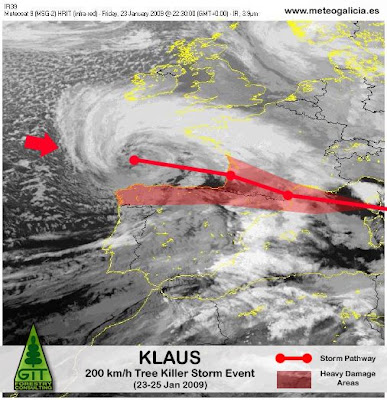Largest Eucalyptus and Pinus forests in Europe blown down?
From January 23d to 25th 2009 the 200 km/h strong wind and rainstorm Klaus swept accross the Bay of Biscay en route to the Mediterranean Sea, causing widespread damage in Northern Spain and Southern France.

(See more images of wind damage to trees & infrastructures in Northwestern Spain)
The unusual, sudden and very fast wind blast, with intensities roughly equivalent to a Category 3 Hurricane for a short time, caused catastrophic damage to mixed forests in Galicia, Asturias, Cantabria and the Basque Country in Spain, wiping out an important amount of the largest Eucalyptus timberland in Europe before travelling eastwards to level Las Landes d'Aquitaine in France, the largest Martime Pine forest in Europe.

Fig. 1: Pathway of Storm Klaus from the Bay of Biscay to the Mediterranean, depicting heavily affected areas, roughly corresponding with the most productive cultivated timberlands in Europe. Base satellite image courtesy Meteogalicia.
Maximum wind speeds set a new record for measurements in Galicia, surpassing the effects of cyclone Hortensia in 1984. Peak winds caused the worst impact in the Northern coast, where a big chunk of the largest cultivated Eucalyptus rainforest stands; and in the already heavily damaged higher highlands of Eastern Galicia, slowly recovering from previous damage to pine timberlands caused by the worst snow storm in 20 years, happening back in November and December 2008.

Fig. 2: Maximum wind speed readings by weather stations in Galicia during Storm Klaus (23 to 24th January). Base Map courtesy Meteogalicia.
Catastrophic Damage Areas for Pine & Eucalypt Forests in Galicia (NW Spain)
Cross-checking wind impact cartography with timber resource allocation maps allows to roughly define those areas where winds in excess of 135 km/h have caused heavy to catastrophic damage to tree plantations, windmill farms and varied industrial, communications and urban infrastructures.

Fig. 3: Catastrophic damage areas caused by Storm Klaus to Eucalyptus plantations in Galicia (Northwestern Spain). Top wind speed (km/h) remarked for each area. Base Maps courtesy EUITF - Universidad de Vigo.

Fig. 4: Catastrophic damage areas caused by Storm Klaus to Pinus plantations in Galicia (Northwestern Spain). Top wind speed (km/h) remarked for each area. Base Maps courtesy EUITF - Universidad de Vigo.
Largest Maritime Pine forest in Europe wiped out
After bashing the Northern coast of Spain, the Eye of Klaus impacted continental Europe in the French coast near Bordeaux, causing widespread damage to anything standing in its way to Marseilles. And in its way, the forest of Les Landes de Gascogne, the largest and most productive of its kind in Europe.

(See more images of wind damage to trees & infrastructures in Southern France)
French forestry officers have made a preliminary balance with grim perspectives, as roughly 60% of this impressive wood resource may have been heavily affected, including some 300,000 hectares of pine timberland receiving catastrophic wind damage.
UPDATE: Klaus Stormwood Inventory (Galicia, Spain)


UPDATE: Storm Xynthia hits Galician forests... again!


Contact / subscribe to Eucalyptologics
© 2007-2010 Gustavo Iglesias Trabado. Please contact us if you want to use all or part of this text and photography elsewhere. We like to share, but we do not like rudeness.



































![Validate my Atom 1.0 feed [Valid Atom 1.0]](http://gus.iglesias.googlepages.com/valid-atom.png)




















16 Comments by our readers :::
Posted: Mon Jan 26, 2009 10:03 pm
It just goes to show how some places are equipped for storms, and some aren't. It seem this big storm brought 62mph winds to Spain which destroyed a building. 62mph winds here are common we get them every Autumn/Winter without fail, and it's a comparative breeze compared to some of the winds get on the western coasts.
It just shows you how some areas are built with calmness in mind whereas were able to take wind.
In the central USA and Canada they can take metres of snow whereas UK can't even deal with 5cm - I guess it's the same principle. Remarkable really.
Posted: Tue Jan 27, 2009 5:01 am
I think you're right about lack of prevention where events as these are rare to very rare. 60 mph is also common for coastal gales here in the NW. But this time we got +120 mph! (max wind speed over 195 km/h). I do not recall something like this since 1984, and that one was milder. Northwestern Spain is a chaos. First piece of land Klaus noticed en route to France, so it beat us quite hard.
A wild guesser mentioned +50 million trees down around here. And power lines, windmills, ships... also went down.
Posted: Tue Jan 27, 2009 11:36 am
wow Gus that looks horrific. Certainly not the 62mph that was quoted in the news. Definitely over 100mph to do that damage
I always wish every winter for some very strong winds (maybe 80-100mph) to create some interest, but I would never wish that damage on anyone!
Posted: Tue Jan 27, 2009 11:42 am
Woops, I kind of missed that as well,... Looks terrible indeed!
If you think that was horrible (and it was), then have a look at Southwestern and Southern France. The biggest Maritime Pine forest in Europe is no more. +250,000,000 trees might easily be down.
To put the numbers in context, I was reading about a roughly similar impact event hitting Scandinavia some years back. For people to understand what is down, the idea for that case was that a 3 meter height x 3 meter wide (10 x 10 feet) wood pile made from the fallen trees would be long enough as to walk over it from Stockholm to Australia.
Tue Jan 27, 2009 5:37 pm
Gus....that looks terrible :-(
Is that the pine forest in Landes, France that have been destroyed? I have regularly driven through that region in the way to Portugal and noticed kilometer after kilometer of forest each side of the road, it would be terrible to think that had all been destroyed?
Have you suffered much damage?
Terrible indeed. Those are photos from Bordeaux to the Spanish border. Similar landscape if you make a triangle to Marseilles.
Les Landes d'Aquitaine do not longer exist. Not as we knew them. I read that French authorities made a preliminary estimation as 60% of it has been heavily damaged or totally destroyed. To put it in context, in area terms that is roughly equivalent to the whole of Greater London being levelled in 10 hours.
Not personally damaged here, as I am luckily inland and we peaked between just 100 and 110 km/h around. Some losses in my trees but nothing that can be compared to what I have seen in the last 3 days. This is total chaos. I have not yet managed to get access to the timberlands in the higher highlands, but I expect grim things as they reached +180 km/h there too. Secondary roads were blocked, so go figure how lanes can be.
Some 10% of the largest Eucalyptus forest in Europe might be down, according to initial unofficial data. Might well be conservative also.
Klaus will be remembered for a long time.
Posted: Tue Jan 27, 2009 6:43 pm
Our experience in Southern England in 1987 and 1990 was very educational. Millions of trees, many in ancient woodlands and famous botanical gardens, were destroyed and there was a great rending of garments and a collective gnashing of teeth that the landscape would never recover.
In hindsight, these storms were a part of the natural succession of forests. A high proportion of the trees that fell were mature and in the latter stages of their lives anyway. Twenty years later, the landscape has largely repaired itself, with little intervention, and people involved in forest management say that they have learned much from the experience and, as I understand it, propose to take an even less interventionist approach to future storms.
It reminds me a bit of the way Californians learned to stop clearing brush from the Redwood forests on the basis that it was a fire hazard - they discovered that, by stopping small fires, they were preventing the forest's well-established renewal process and encouraging less frequent and more genuinely damaging fires.
The loss of life and destruction of property in France and Spain is very upsetting, but the forests can take care of themselves - much better than we can.
There is an important difference David. Most of these forests described above are not ancient woodlands subject to natural succession. They are cultivated forests in which succession is artificially managed by men to accelerate the production cycles of a renewable and recyclable primary resource.
Each operational step of a way that might well have started 40 years ago has meant an associated operating cost, which was to be theoretically recovered, allowing to cover the expenses of further regeneration, and obtaining a profit.
What happened these days in those areas was an evaporating profit, the need of cleaning up the mess (further cost) before wood value is totally lost by rotting (sliding down from profit to net loss), and not having the alternative of choosing "not to regenerate artificially again but leaving it to natural succession" (so, further cost to generate future profit), since these productive forests sustain key industries producing commodities we all use everyday, both where we have cultivated forests and where we do not.
Demand keeps raising as we speak no matter what happened (maybe not visibly in the shortest term today, but will visibly rebound in increased numbers with the next "economic boom", for which moment the levelled trees must be standing once more, and ready to do their duty -feeding our consumer habits- once again).
My main conclusion is that an impressive amount of money belonging to an impressive amount of stockholders has just gone with the wind. And we are in a moment of global financial crisis in which injecting money to keep ships afloat is a big problem. For private and public sectors alike. Banks are too busy trying to save their own arses from the maelstrom a few bubble-makers created when it all burst off.
Posted: Tue Jan 27, 2009 11:19 pm
Some of those shots remind me of hurricane damage I've seen in the SE USA, the most impressive one being Andrew in southern Dade County in Florida. The highest measured sustained wind speed was 285 km/h (175 mph) with a minimum central pressure of 922 mbar. I missed that storm, but I did venture there 2 weeks later to help clean out a friend's home. After that one nothing stood!
Regarding the economic impact, there is no doubt that it will be felt for a long time. At least the damage is recoverable. After Katrina in 2005 America lost one of its primary cities and that place has yet to recover fully. I've wondered what would happen if Miami were hit head on by a Category 5 - or Houston - or if New Orleans received an encore? How do you afford to build a major city from scratch?
Of course my thoughts and prayers go out to everyone effected.
Posted: Wed Jan 28, 2009 5:15 am
Wow! O_O Those photos are harsh! ...sounds frightening, we get the occassional bad storm here but I haven't seen damage quite like that.
You're right Gus, but I was really thinking about Les Landes when I was writing, not the plantations in the photos.
But David, Les Landes is not ancient woodland either. It was mostly a swamp before being gradually planted with pines by men since the late 1800's. Excepting some patches of mixed species semi-natural forest remaining, it is a man-made forest. As most of those in Western Europe!
In fact, it is (or was) the largest plantation of Maritime Pine in Europe. And even if natural regeneration happens by seed where management regimes think it is proper, this is successful because of older stands being clear-cut to harvest timber and let a newer stand develop in its place!
I live inland from Les Landes in the Midi-Pyrénées where we experienced winds of 160 to 180 kms. An aggravating factor was the torrential rain of the night of thursday 22nd and all day and night of friday 23rd and into saturday 24th. We had over 75mm in this time. This allowed tremendous movement at the root level and has resulted in entire plantations of poplars being laid flat where they have been heaved over by the winds. It has been calculated that about 80% of the plantation poplars in this area, over 6 years old have been destroyed. From my memory this was the same set of circumstances in Southern England in 1987. The same has happened with many conifers, they have been heaved out of the ground like giant plugs. My own plantings of eucalyptus have suffered alot of damage, being planted mainly on heavy clay soils that are completely saturated. They have suffered socketing, even the newly planted (september 2008) seedlings of 40/60cm. I can only wait and see if they will recover when the ground dries out. It will all depend on how much root damage there has been around the root collar. This doesn't mean we should give up planting trees. I have already lost a couple of orders due to the worry that 'they may blow over in a wind'.
Thank you for the report Howard. Glad to see you are okay and your eucalypts in France have coped relatively well. What the wind did to the poplars in Aquitaine and the Midi-Pyrenées is quite scary too. I have added one of your photos to this other post showing examples of damage in Spain & France.
The Hungarian Federation of Forestry and Wood Industries (Fagazdasági Országos Szakmai Szövetség) has kindly used our information for FATÁJ-online.
You can find their report to the Forestry Industry at Klaus vihar pusztítása - legalább 50 millió m3 faanyag.
Send a comment to EUCALYPTOLOGICS